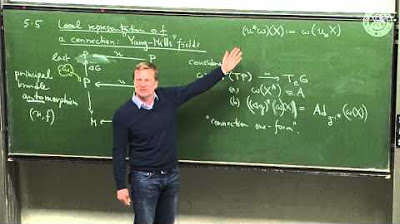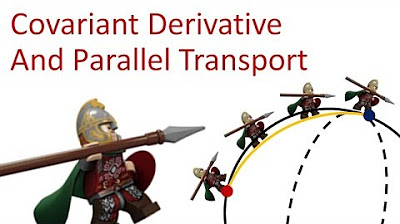Conncections and connection 1-forms - Lec 21 - Frederic Schuller
TLDRThe video script delves into the concept of connections on a principal bundle in the context of differential geometry and physics. It begins by differentiating between the common use of the term 'connection' and its specific meaning within the study of bundles. The lecturer introduces a connection as a structure on a principal bundle that enables the definition of parallel transport and covariant derivatives, particularly relevant in general relativity and gauge theory. The script explains how a connection is technically a one-form on the principal bundle, yet it is defined through the choice of horizontal subspaces at each point of the bundle. This choice is intricately linked to the action of the group associated with the bundle. The properties of the connection one-form are explored, including its behavior under the action of the group and its smoothness, which are essential for defining parallel transport. The script concludes by emphasizing that parallel transport can be defined without a covariant derivative, and the connection on a principal bundle can extend to associated bundles, a concept crucial for applications in physics and geometry.
Takeaways
- 📐 **Connections on Principal Bundles**: The lecture introduces the concept of connections on a principal bundle, which are structures that allow for the definition of parallel transport and covariant derivatives in the context of differential geometry and physics.
- 🔗 **Right Action and Vector Fields**: The right action of a group G on a principal bundle induces a vector field for each element of the Lie algebra of G, which is crucial for defining the connection.
- 🧲 **Lie Algebra Homomorphism**: A map I is defined that takes elements of the Lie algebra to corresponding vector fields on the principal bundle, and this map is shown to be a Lie algebra homomorphism.
- 📉 **Vertical Subspace**: The vertical subspace at a point P of a principal bundle is defined as the kernel of the push forward of the bundle projection, which is key to understanding the local structure of the bundle.
- 🤝 **Compatibility with Group Action**: A connection must be compatible with the right action of the group G, meaning that the push forward of the horizontal space under the action of any group element should map to the horizontal space at the new point.
- ↕️ **Unique Decomposition**: Every vector in the tangent space at a point of the principal bundle has a unique decomposition into a horizontal part (related to the connection) and a vertical part (related to the group action).
- 📏 **Connection 1-Form**: The connection on a principal bundle is technically encoded as an algebra-valued 1-form, which is a linear map from the tangent space at each point to the Lie algebra of the group.
- 🔍 **Recovery of Horizontal Subspaces**: The horizontal subspace at a point can be recovered from the connection 1-form as the kernel of the 1-form at that point.
- 🧬 **Transformation Properties**: The connection 1-form transforms under the pullback by the inverse of the adjoint action of the group element, reflecting the compatibility of the connection with the group action.
- 🌀 **Smoothness of the Connection**: The connection 1-form is smooth, which is a requirement for the connection to be well-defined and usable in the study of parallel transport and covariant derivatives.
- ⚙️ **Applications in Physics**: Connections on principal bundles are fundamental in physics, particularly in the formulation of gauge theories, and are used to define parallel transport and covariant derivatives which are essential for the mathematical description of phenomena like curvature and field strength.
Q & A
What is a principal bundle?
-A principal bundle is a mathematical concept in differential geometry where there is a smooth manifold, a group G, and a projection map that locally looks like a product space of the base manifold and the group G. It is used as a foundational structure in gauge theory and fiber bundles.
What is the significance of a connection on a principal bundle?
-A connection on a principal bundle is a structure that allows for the definition of parallel transport on the bundle. It is significant because it provides a way to connect neighboring fibers in a consistent manner, which is crucial for defining covariant derivatives when the associated bundle is a vector bundle.
How is a connection on a principal bundle typically represented?
-A connection on a principal bundle is often represented by a one-form on the bundle, taking values in the Lie algebra of the structure group. This connection one-form encodes the choice of horizontal subspaces at each point of the bundle.
What is the role of the Lie algebra in defining a connection on a principal bundle?
-The Lie algebra plays a crucial role as it is used to generate vector fields on the principal bundle through the action of its elements. The connection one-form maps tangent vectors to elements of the Lie algebra, which is key in defining the horizontal spaces of the connection.
What is the concept of a vertical subspace in the context of a principal bundle?
-The vertical subspace at a point P of a principal bundle is the kernel of the push-forward of the projection map. It consists of all vectors in the tangent space at P that are mapped to zero by the projection map, and it is essentially the tangent space of the fiber through point P.
How does the choice of a horizontal subspace affect the decomposition of a vector in the tangent space of a principal bundle?
-The choice of a horizontal subspace determines the unique decomposition of any vector in the tangent space into horizontal and vertical components. Both the horizontal and vertical parts depend on this choice, and this decomposition is crucial for defining parallel transport and covariant derivatives.
What is the transformation behavior of a connection one-form under a change of the horizontal subspace?
-The connection one-form, which encodes the choice of horizontal subspaces, will change if the horizontal subspace changes. This transformation behavior is important for understanding how the connection behaves under different choices of horizontal subspaces.
What is parallel transport and how is it related to a connection on a principal bundle?
-Parallel transport is a concept that allows for the movement of vectors along paths in a manifold without changing their direction relative to a chosen frame, which is defined by a connection. In the context of a principal bundle, a connection implies a parallel transport on the bundle and any associated fiber bundle.
What are the properties that a one-form must have to be considered a connection one-form on a principal bundle?
-A connection one-form must be smooth and satisfy two key properties: (a) when applied to a vector field generated by an element of the Lie algebra, it yields the corresponding Lie algebra element, and (b) it is invariant under the pullback by the right action of the group, up to the adjoint action.
How does the concept of a covariant derivative relate to a connection on a vector bundle?
-A covariant derivative is a generalization of a derivative to curved spaces or manifolds. On a vector bundle, a covariant derivative can be defined if the fiber carries a vector space structure. If the vector bundle is an associated bundle of some principal bundle, the covariant derivative can be defined in terms of a connection on the principal bundle.
What is the importance of the smoothness of the connection one-form?
-The smoothness of the connection one-form is important because it ensures that the horizontal and vertical lifts of smooth vector fields are also smooth. This property is essential for the well-definedness of parallel transport and covariant derivatives associated with the connection.
Outlines
📚 Introduction to Principal Bundles and Connections
The video begins with an introduction to the concept of adding structure to a manifold, specifically through principal bundles. It discusses the right action of a group G on the bundle and the importance of understanding connections in the context of differential geometry and general relativity. The video clarifies that a connection is not just a covariant derivative or parallel transport but is a structure on a principal bundle that implies these properties.
🔍 Defining Vector Fields on Principal Bundles
The script moves on to describe how elements from the Lie algebra of a group G can induce vector fields on the principal bundle P. It introduces the map I, which is a Lie algebra homomorphism, and discusses the definition of the vertical subspace at a point P in the bundle, which is the kernel of the push forward of the projection.
🌐 Visualizing the Vertical Subspace
The video provides a visual explanation of the vertical subspace, showing how it corresponds to the fibers of the principal bundle. It explains the concept of the push forward of the projection and how it relates to the tangent vectors within the vertical subspace, using the action of the group to generate a curve within the fiber.
🔄 The Idea of a Connection
The script delves into the concept of a connection on a principal bundle, which involves making a choice to connect individual points of neighboring fibers. It discusses the idea of identifying points across different fibers and the need to make a choice of a complementary subspace to the vertical space at each point in the bundle.
📏 Properties of the Horizontal Subspace
The video outlines the properties that a connection on a principal G bundle must satisfy. It emphasizes the need for the horizontal subspace at each point to be chosen in a way that is compatible with the right action of the group and that the choice varies smoothly across the bundle.
🧲 Connection One-Form and its Relation to Horizontal Subspaces
The script introduces the connection one-form, which encodes the choice of horizontal subspaces at each point in the principal bundle. It explains how the connection one-form, denoted as Omega, is defined and how it can be used to recover the horizontal subspace as its kernel.
🔗 Pullback and Action of the Group on the Connection One-Form
The video discusses the action of the group on the connection one-form through pullback and how it reflects the compatibility condition of the horizontal space with the right action of the group. It also touches on the smoothness of the connection one-form and its implications for the decomposition of vectors into horizontal and vertical parts.
📝 Proof of the Properties of the Connection One-Form
The script presents a proof that demonstrates the properties of the connection one-form, showing that it extracts the Lie algebra element that generates the vector field when applied to a vertical vector field. It also shows that the pullback of the one-form under the action of the group satisfies certain properties, which are crucial for the connection's definition.
🔬 Smoothness of the Connection One-Form and its Implications
The video concludes with a discussion on the smoothness of the connection one-form and how it is derived from the smoothness of the map I and its inverse. It highlights the convenience of defining a connection through a one-form with specific properties and suggests that the next topic will be parallel transport on the principal bundle and associated fiber bundles.
Mindmap
Keywords
💡Manifold
💡Principal Bundle
💡Connection
💡Covariant Derivative
💡Parallel Transport
💡Vector Bundle
💡Lie Algebra
💡Section
💡One-form
💡Horizontal Subspace
💡Adjoint Representation
Highlights
Introduction to adding structure to a manifold, specifically focusing on principle bundles.
Explaining the concept of connections on a principle bundle and their relation to covariant derivatives and parallel transport.
Clarification that the term 'connection' is not synonymous with covariant derivative or parallel transport in all contexts.
Description of a connection as a structure on a principle bundle that implies parallel transport on the principle bundle and associated bundles.
Special case discussion where the fiber bundle is a vector bundle, allowing for the definition of a covariant derivative.
The connection on a principle bundle is revealed to be a one form, simplifying the concept.
Discussion on the local form of a connection and the necessity of choosing a section for localization.
Introduction of the map 'I' which is a Lie algebra homomorphism, linking Lie algebra elements to vector fields on the principle bundle.
Definition and importance of the vertical subspace in the context of the tangent space at a point on the principle bundle.
Lemma stating that the vector field generated by Lie algebra elements lies within the vertical subspace of the principle bundle.
The idea of a connection is to make a choice of how to connect individual points of neighboring fibers in a principle bundle.
Formal definition of a connection as an assignment of a vector subspace (horizontal subspace) at every point of the principle bundle.
Compatibility condition for the connection with the right action of the group, ensuring smooth transition between fibers.
The connection one form, Ω, is introduced as a way to encode the choice of horizontal subspaces.
Properties of the connection one form Ω, including its behavior under the pullback by group actions.
Smoothness of the connection one form Ω, and its implication for the smoothness of the connection.
Proof that a connection one form with certain properties defines a unique connection on the principle bundle.
Discussion on how the connection on a principle bundle gives rise to parallel transport on the principle bundle and associated fiber bundles.
Distinction between parallel transport and the need for a covariant derivative, especially in the context of non-Abelian gauge theory and physics.
Transcripts
Browse More Related Video

Covariant derivatives - Lec 25 - Frederic Schuller

Parallel transport - Lec 23 - Frederic Schuller

Associated fibre bundles - Lec 20 - Frederic Schuller

Local representations of a connection on the base manifold: Yang-Mills fields - Lec 22

Joe Rogan - Eric Weinstein Explains Gauge Symmetry

Tensor Calculus 18: Covariant Derivative (extrinsic) and Parallel Transport
5.0 / 5 (0 votes)
Thanks for rating: